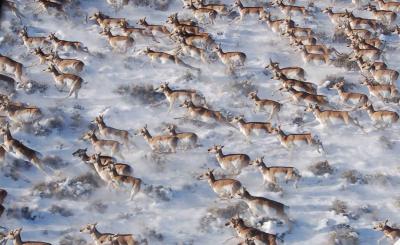How to protect an American wildlife legacy

This image depicts a herd of running pronghorn. Credit: Joel Berger
A new paper shows that while science plays a critical role in informing conservation action, scientists must move beyond the realm of their expertise into less familiar areas like public relations, education, and even politics, to ultimately meet America's conservation goals.
The paper, “Moving Beyond Science to Protect a Mammalian Migration Corridor,” appears in the current online edition on the journal Conservation Biology, and will appear in Volume 28 of the print edition. Authors are Joel Berger of the Wildlife Conservation Society (WCS) and the University of Montana, Missoula, and Steve Cain of Grand Teton National Park (Grand Teton).
In their paper, the authors examine the process that led to the creation of the United States' first federally designated migration corridor—Wyoming's Path of the Pronghorn (POP). The POP is a 93-mile route travelled by Grand Teton's pronghorn between their summering range in the park (where females give birth) and their wintering range in Upper Green River Valley.
Pronghorn have made this journey for more than 6,000 thousand years, but increasingly face the modern day challenges of bottlenecks and barriers created by roadways, fences, and energy development. Designation of the corridor, which both Berger and Cain worked to bring about, led to the protection of the migration. Without this corridor, one of the western United States' iconic species would ultimately vanish from Grand Teton. “The POP is a critical life-link to pronghorn in the park, where native ungulates and predators, including grizzly bears and wolves, are formidable drivers of the ecological system,” Cain said.
While science played a vital role in generating data on this landmark project, the paper illustrates that science is only an initial phase in creating a desired conservation result.
“We chose this project as a case study to show that science alone cannot achieve real world outcomes and that conservation is the provenance of the people,” said Berger. “The Path of the Pronghorn migration, in terms of ecological, historical, and cultural relevance, is a distinctly American treasure. As scientists there at the beginning, we had to illustrate that significance and get that message to the American public.”
The scientists were initially faced with a lack of recognition for migrations and their importance. In response, they sought out an understanding of Wyoming's demographic, social, and ecological make-up, and then built local and broader public consciousness around the migration issue. They met with energy companies and elected officials (including then-Governor of Wyoming, Dave Freudenthal), engaged the media and published opinion pieces in national outlets, mobilized the conservation community, and conducted presentations and workshops for municipalities, businesses, non-governmental organizations, and local, state and federal agency officials.
The paper notes that “activism, science, trust and engagement at levels involving very basic cultural values were all important ingredients in building support for POP.” These efforts, “required those involved to move away from science and become part-time information brokers and part-time conservation advocates.”
Berger said, “Not all audiences were immediately receptive, but ultimately trust was built between the scientists and the public who began to recognize the global, biological, historical and economical significance of the migration as an icon of the American West.”
While the paper notes that no blueprint achieves conservation outcomes in all cases, the POP case study revealed several key elements that contributed to success. These included:
1) the development of ecological insights and publications to frame issues and establish credibility;
2) a collaboration between WCS and the National Park Service that enabled opportunities and access to other agencies and NGOs;
3) support from energy producers that facilitated meetings with elected officials; and
4) targeted communications and outreach, and engaging county commissioners, ranchers, local and national NGOs, politicians and state and federal agencies.
Berger and Cain also note that a “thick skin” and calm demeanor are invaluable assets and that while science was a critical part of the discovery and ultimate designation of the POP, “human dimensions played a larger role.”
Media Contact
All latest news from the category: Ecology, The Environment and Conservation
This complex theme deals primarily with interactions between organisms and the environmental factors that impact them, but to a greater extent between individual inanimate environmental factors.
innovations-report offers informative reports and articles on topics such as climate protection, landscape conservation, ecological systems, wildlife and nature parks and ecosystem efficiency and balance.
Newest articles

Long-sought structure of powerful anticancer natural product
…solved by integrated approach. A collaborative effort by the research groups of Professor Haruhiko Fuwa from Chuo University and Professor Masashi Tsuda from Kochi University has culminated in the structure…

Making a difference: Efficient water harvesting from air possible
Copolymer solution uses water-loving differential to induce desorption at lower temperatures. Harvesting water from the air and decreasing humidity are crucial to realizing a more comfortable life for humanity. Water-adsorption…

In major materials breakthrough
UVA team solves a nearly 200-year-old challenge in polymers. UVA researchers defy materials science rules with molecules that release stored length to decouple stiffness and stretchability. Researchers at the University…



